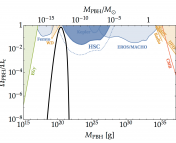Title: Observational signatures of microlensing in gravitational waves at LIGO/Virgo frequencies in gravitational waves at LIGO/Virgo frequencies
Authors: J.M. Diego, O.A. Hannuksela, P.L. Kelly, T. Broadhurst, K. Kim, T.G.F. Li, and G.F. Smoot
First Author’s Institution: Instituto de Física de Cantabria (CSIC-UC)
Status: Open access on arXiv
So far, LIGO and VIRGO have detected 11 gravitational wave events – the ripples in spacetime that have travelled to us from violent collisions of black holes and neutron stars. As upgrades take place and new detectors come online, we will hopefully see tens of these types of event over the coming years. This is exciting stuff in its own right, but today’s authors have added another layer of intrigue to these future detections – they might be able to tell us about what lies betwixt us and these mergers, which could include stars, remnants of galaxies, or even primordial black holes.
What is microlensing?
The idea is that as a gravitational wave travels towards us after being produced by a really violent event like a black hole merger, it has to pass through all of the structure that lies in its path on the journey to our detectors on Earth. If the structure in its wake is massive enough, the spacetime around it will be curved (see here for a classic demonstration) and the gravitational wave signal that shows up in our detectors will be distorted. When the objects are relatively small, this process is known as microlensing, and the objects doing the distorting are known as the lenses.
Usually, microlensing is done with light from nearby galaxies – we look for distorted light curves in our telescopes caused by objects passing between us and the galaxy (see here, here and here for some astrobites on regular microlensing). It’s exactly the same with gravitational waves, except that it’s the waveform of the gravitational wave that will be disfigured. An interference pattern is produced because the lens causes us to see more than one ‘image’ of the gravitational wave. These images are separated by time delays, and therefore interfere with each other as we detect the signal from the gravitational wave.
Of particular interest to today’s authors are stellar-mass lenses. Anything between around 1 and 100 solar masses could act as a lens, but up until now the effect on the gravitational wave signal has been shown to be modest for lenses this small, because the time delays between multiple images are very short. However, today’s paper argues that once you take into account the fact that the lens is sat on top of other structures – maybe within a cluster or a galaxy, the effect can be much larger.
Layering lenses
The authors calculate the effect of the overarching structure of the galaxy, group of galaxies or cluster on a gravitational wave passing through it, and then add in the effect of different types of stellar-mass lenses on top. They find that usually two images of the gravitational wave are produced by the large-scale structure, and then these images are broken up into more images by the small lens. The time delays between the gravitational wave signals are therefore amplified and an interference pattern could show up in our detectors. The pattern depends on the type of lens – this is shown in figure 1, where the black solid line is an unlensed gravitational wave signal, and the coloured dashed lines are the distorted signals from various different types of lens. The letters correspond to different microlenses, while the positive and negative signs denote different models for the overarching structure, or ‘macromodel’.

Figure 1: the strain of a gravitational wave signal from two merging black holes as a function of time. The solid black line shows the unlensed signal, whereas the dashed coloured lines are various different lensed signals. From today’s paper.
At the moment, this type of interference is going to be hard to detect because it occurs at high frequencies (frequency increases as you go to the left of the plot in figure 1), which are not in the optimal ranges of LIGO or VIRGO. However as new detectors come online with improved sensitivities, for example KAGRA in Japan and the LIGO-India project, these types of interference patterns may be detectable. It will be important to recognise these signals, because if the lensing is due to regular astrophysical sources like stars or galaxies, then many gravitational waves will be unavoidably lensed and we risk missing lots of events if we don’t search for these types of distortions. If, however, the lensing is done by something more exotic like a primordial black hole, a detection of this type of interference pattern could pave the way for an important discovery.




